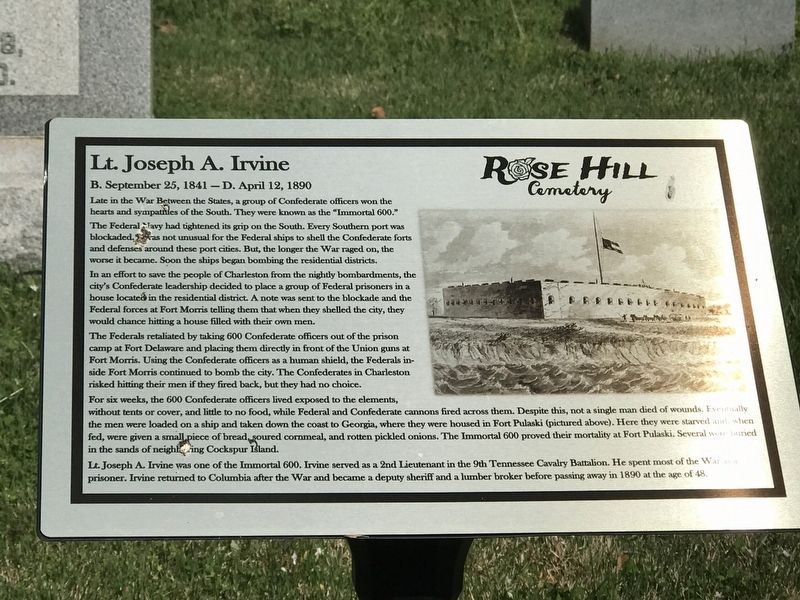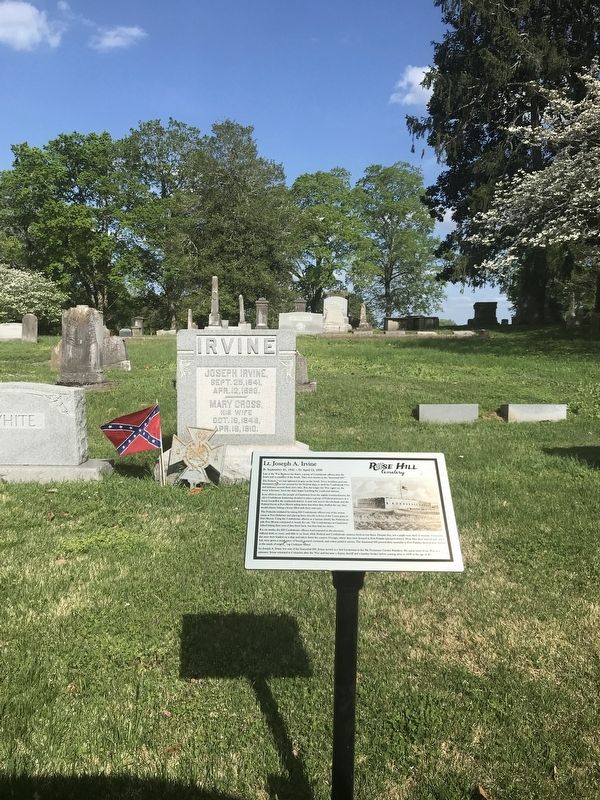Columbia in Maury County, Tennessee — The American South (East South Central)
Lt. Joseph A. Irvine
B. September 25, 1841 - D. April 12, 1890
The Federal navy had tightened its grip on the South. Every Southern port was blockaded. It was not unusual for the Federal ships to shell the Confederate forts and defenses around these port cities. But, the longer the War raged on, the worse it became. Soon the ships began bombing the residential districts.
In an effort to save the people of Charleston from the nightly bombardments, the city's Confederate leadership decided to place a group of Federal prisoners in a house located in the residential district. A note was sent to the blockade and the Federal forces at Fort Morris telling them that when they shelled the city, they would chance hitting a house filled with their own men.
The Federals retaliated by taking 600 Confederate officers out of the prison camp at Fort Delaware and placing them directly in front of the Union guns at Fort Morris. Using the Confederate officers as a human shield, the Federals inside Fort Morris continued to bomb the city. The Confederates in Charleston risked hitting their men if they fired back, but they had no choice.
For six weeks, the 600 Confederate officers lived exposed to the elements, without tents or cover, and little to no food, while Federal and Confederate cannons fired across them. Despite this, not a single man died of wounds. Eventually the men were loaded on a ship and taken down the coast to Georgia, where they were housed in Fort Pulaski (pictured above). Here they were starved and, when fed, were given a small piece of bread, soured cornmeal, and rotten pickled onions. The Immortal 600 proved their mortality at Fort Pulaski. Several were buried in the sands of neighboring Cockspur Island.
Lt. Joseph A. Irvine was one of the Immortal 600. Irvine served as a 2nd Lieutenant in the 9th Tennessee Cavalry Battalion. He spent most of the War as a prisoner. Irvine returned to Columbia after the War and became a deputy sheriff and a lumber broker before passing away in 1890 at the age of 48.
Erected by Rose Hill Cemetery.
Topics. This historical marker is listed in these topic lists: Cemeteries & Burial Sites • War, US Civil. A significant historical date for this entry is September 25, 1841.
Location. 35° 36.258′ N, 87° 1.743′ W. Marker is in Columbia, Tennessee, in Maury County. Marker can be reached from the intersection of Cemetery Street and South Glade Street, on the right when traveling north. Marker is located in Block M of Rose Hill Cemetery. Touch for map. Marker is at or near this postal address: 219 Cemetery St, Columbia TN 38401, United States of America. Touch for directions.
Other nearby markers. At least 8 other markers are within walking distance of this marker. Capt. Meade Frierson (here, next to this marker); Nathan Vaught (within shouting distance of this marker); Capt. John Gordon (within shouting distance of this marker); Brigadier General John Carpenter Carter (within shouting distance of this marker); Rev. Franklin Gillette Smith (about 300 feet away, measured in a direct line); Alfred Osborn Pope Nicholson (about 400 feet away); Major Nathaniel F. Cheairs (about 500 feet away); Edward Franklin “Pop” Geers (about 500 feet away). Touch for a list and map of all markers in Columbia.
Credits. This page was last revised on April 26, 2022. It was originally submitted on April 26, 2022, by Duane and Tracy Marsteller of Murfreesboro, Tennessee. This page has been viewed 100 times since then and 14 times this year. Photos: 1, 2. submitted on April 26, 2022, by Duane and Tracy Marsteller of Murfreesboro, Tennessee.

